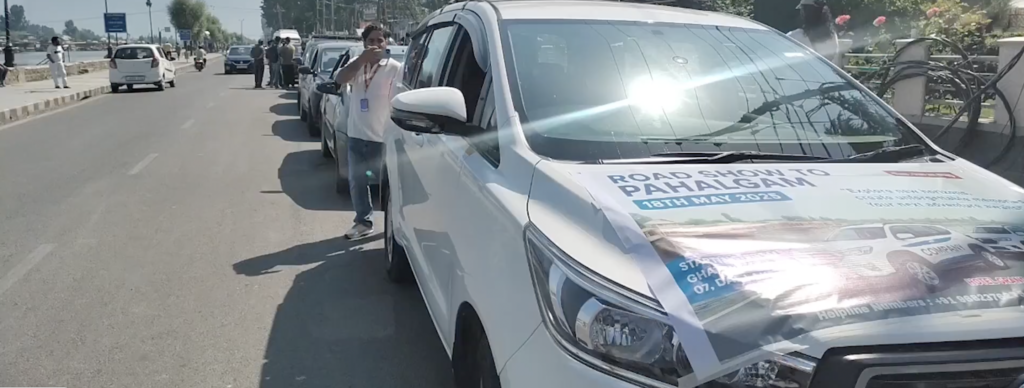Srinagar/Anantnag, May 19, 2025 – A vibrant road show, comprising nearly 300 vehicles, set off from the serene banks of Dal Lake in Srinagar on Sunday, May 18, heading toward Pahalgam to send a resounding message of peace and resilience. Organized by Kashmir’s tourism stakeholders, the “Kashmir is Calling” initiative sought to revive the region’s battered tourism industry, crippled by the April 22 Pahalgam terror attack that claimed 26 lives, mostly tourists. The rally, though halted in Anantnag, 30 km short of Pahalgam due to security concerns, succeeded in showcasing Kashmir’s unity and readiness to welcome visitors once more.
The Pahalgam attack in Baisaran Valley, a scenic meadow known as the “Mini Switzerland of India,” triggered an exodus of tourists, widespread cancellations, and a near-total shutdown of Kashmir’s tourism sector, a vital economic lifeline. Hotels emptied, shikara rides on Dal Lake halted, and local livelihoods—from pony operators to shawl sellers—faced devastation. “Bookings vanished overnight after April 22,” said Amir Majeed, a tour operator and lead organizer of the road show. “This rally is our answer: Kashmir is safe, and we’re ready to host tourists again.”
The caravan, adorned with banners reading “Welcome to Paradise” and slogans like “Invest in Kashmir’s Future, Tourism and Peace Go Hand in Hand,” included hoteliers, shikara operators, transporters, tour guides, artists, and local youth. Flagged off by Tanvir Sadiq, a legislator from Chief Minister Omar Abdullah’s National Conference, the event saw participants chanting “Aman Ka Paigham — Kashmir Ki Shaan!” (Message of Peace — Pride of Kashmir). In Bijbehara, locals greeted the convoy with tea, snacks, and warm gestures, reinforcing Kashmir’s famed hospitality.
“This isn’t just about business; it’s about our identity,” said Riyaz Ahmed, a Srinagar hotelier. “Tourism connects us to the world, and we’re inviting tourists into our homes and hearts.” The rally, initially planned to culminate in Pahalgam, concluded in Anantnag at the request of the Jammu and Kashmir Police, who cited lingering security risks in the Pahalgam area. Despite this, organizers declared the mission accomplished. “Our message of peace and welcome reached its destination,” Majeed noted.
Security has been significantly bolstered since the attack, with increased checkpoints, surveillance, and joint patrols in tourist zones. Chief Minister Omar Abdullah, addressing the tourism crisis, expressed dismay at the “lost summer season” but emphasized efforts to ensure a safe Amarnath Yatra, starting July 3, as a stepping stone to broader tourism recovery. “We’re fighting a war of perception,” said Sadiq, urging tourists nationwide to return and stand with Kashmiris against terrorism.
The road show’s festive spirit, with folk artists performing Rouf dances and children waving peace flags, contrasted with the region’s recent grief. Locals in Anantnag offered traditional Kehwa, and travel blogger Waseem Ahmad, live-streaming the event, called it “the Kashmir I want my children to grow up in.” Posts on X echoed this sentiment, with users praising the initiative as a bold step toward healing and revival.
The event comes amid broader challenges, including recent powerful winds that damaged infrastructure across the Kashmir Valley and ongoing recovery from cross-border tensions linked to Operation Sindoor. Yet, the road show underscored Kashmir’s resilience. Manzoor Kundroo, a participant from Great Himalayan Travels, hinted at more such events, declaring, “Kashmiris are ready to welcome tourists again.” As the region prepares for the Amarnath Yatra and beyond, the road show stands as a powerful call to reclaim Kashmir’s identity as a paradise of peace and hospitality.



